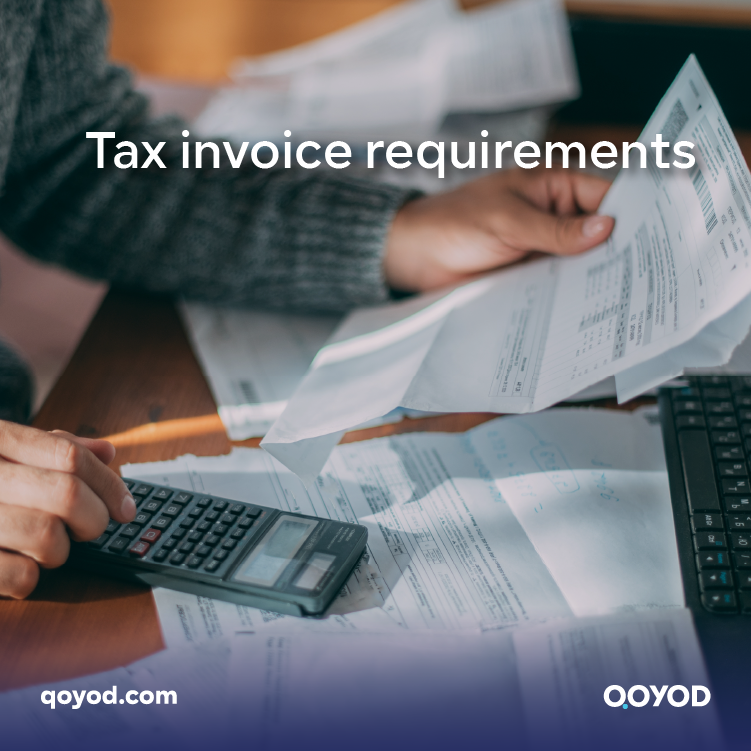Tax invoices are considered essential documents for use by enterprises for their financial transactions related to both sales of goods or services subject to value-added tax, and tax invoices are issued for business-to-business (B2B) transactions or business-to-government (B2G) transactions. In this article, we seek to introduce the tax invoice, its conditions, and how to comply with these conditions.
The importance of knowing the terms of the tax invoice
Issuing any tax invoice is not sufficient in itself, but this invoice must contain all the requirements of the correct and approved tax invoices, so it is necessary for establishments to be aware of all the conditions specified in the country in which they operate or conduct business to ensure compliance with all their tax invoices and thus avoid any violations that may lead to penalties or fines.
Failure to issue a tax invoice in itself is a punishment punishable by law in Saudi Arabia, as are other forms of violations related to tax invoices, such as attempting to collect a tax lower or higher than the imposed tax of 15% or attempting tax evasion, and the absence of a tax number on the tax invoice is a punishable and fined violation.
Tax invoice requirements
The electronic tax bills were applied in two phases in Saudi Arabia: the first phase, namely, the issuance and preservation phase, which began on December 4, 2021, and the second phase, the linkage and integration phase, which began on January 1, 2023, in a phased manner. The terms of the two phases vary slightly. These conditions can be broken down according to the terms of the Zakat, Tax, and Customs Authority, as set out below:
1. Persons in charge
The first condition of the tax invoice is the nature of the persons who are required to issue these invoices, as all taxpayers subject to VAT provisions must issue a tax invoice when making a supply of taxable goods or services, with the exception of taxpayers who are not residents of the Kingdom of Saudi Arabia.
2. Invoice Issuance Mechanism
One of the conditions of the tax invoice is the use of electronic invoicing solutions to issue it, and no program can be used alone; the program must comply with the requirements and standards of the electronic invoicing regulation in the two stages as follows:
First stage
The conditions that must be met in the electronic invoicing program for the issuance of tax invoices in the first stage are as follows:
- The QR code generation feature must be available in the electronic billing program used.
- This program does not contain any of the prohibited features specified by the Zakat, Tax, and Customs Authority, which are the following:
- Unrestricted access.
- The possibility of manipulating electronic invoices or records.
- The software allowed the creation of more than one sequence of tax invoices.
Second stage
The additional conditions that must be met in the electronic invoicing program for the issuance of tax invoices for the second phase, in addition to the conditions of the first stage, are the following:
- The ability of the program to issue and save electronic tax invoices in the required format: XML or PDF/A-3 (including XML format).
- Ensure that the system is able to connect to the Internet.
- The program should be integrated with the system of the Zakat, Tax, and Customs Authority.
3- Language
The Zakat, Tax, and Customs Authority requires that tax invoices be issued primarily in Arabic; Arabic or Hindi numbers can be used in the invoice alike, and the invoice can include any other additional language. For the second stage, the technical aspects of the XML format should be in English.
4: Invoice boxes
The Zakat, Tax, and Customs Authority has identified mandatory boxes that must be available in tax invoices as a condition of the tax invoice to consider it a complete and correct invoice. These rights vary at the two stages of application, and the elements vary according to the type of electronic invoice. This can be explained simply as follows:
First stage
There are several elements that must be met as an additional requirement on the tax invoice for the first stage, and they differ between the tax invoice and the simplified tax invoice as follows:
- Tax invoice: It is the tax invoice that is often issued between one establishment and another, and the required elements are as follows:
- Tax invoice address.
- Serial number, date, and time of issuance of the invoice.
- Bill Quick Response Code (QR).
- Seller information: name, address, and VAT registration number of the seller.
- Buyer information: name, address, commercial registration number, and VAT registration number of the buyer.
- Information about goods or services, such as their name, unit price and quantity, and tax rate and value,.
- Value Added Tax (VAT).
- Total with tax.
- Simplified tax invoice: It is the tax invoice that is often issued between an establishment and a consumer, and the required elements are as follows:
- Tax invoice address.
- Tax invoice number.
- The name and address of the store.
- The date of issuance of the invoice.
- VAT registration number.
- Information about goods or services, such as name, quantity, unit price, and VAT.
- Total taxable amount.
- Value Added Tax (VAT).
- Total with tax.
- Quick response (QR) code.
Second stage
Many additional elements that must be met as an additional requirement on the tax invoice for the second stage have been identified as a condition of the tax invoice, and they also differ between the tax invoice and the simplified tax invoice as follows:
- Tax Invoice: The elements required in the second stage include all the elements required in the first stage, in addition to several other elements as follows:
- The vendor’s commercial registration number, which serves as an additional identifier for the vendor.
- Additional information regarding goods, namely the subtotal or total amount excluding VAT and the total or total amount inclusive of VAT,.
- Total, excluding VAT.
- Simplified tax invoice: The elements required in the simplified tax invoice for the second stage include all the elements required in the first stage as well, in addition to one additional element, which is as follows:
- Price or total amount, inclusive of VAT.
5-Formula
Taxpayers subject to VAT in electronic format using an electronic billing program are required as follows:
First stage
No specific formula is required for the first phase of the tax bill, where taxpayers can issue invoices in any electronic format. It should be noted that the paper-based, handwritten invoice that was subsequently converted into electronic format by copying, using scanners, or other corresponding electronic invoice is not considered to be an electronic invoice, nor is the text-based invoice adopted as an electronic invoice.
Second stage
Tax invoices for the second stage must be issued electronically in XML or PDF/A-3 format (embedded XML format).
Store and share your invoice.
The storage of the invoice is one of the requirements of the tax bill, and electronic invoices must be archived in accordance with the provisions of the value-added tax regulations so that the authority can access them at any time. Persons subject to the electronic billing list must share the tax invoices with the authority through the application programming interface for both accreditation and transmission.
How does Qoyoy help you work with tax invoice conditions?
Qoyod, the best electronic invoicing solution in the Kingdom of Saudi Arabia, is keen to help you issue tax invoices that are subject to all the conditions specified by the Zakat, Tax, and Customs Authority, and it is helped by its many advantages in the field of electronic invoicing, some of which can be mentioned as follows:
- It is easy to use in a way that enables entrepreneurs to manage their accounts themselves.
- Fully compliant with all the authority’s requirements regarding the mandatory fields of the invoice.
- Supports the specific format of the tax invoice, which is XML or PDF/A-3, including XML.
- The ability to add a QR code.
- It does not contain functions prohibited by the authority.
Conclusion
The tax invoice is one of the basic financial documents used by businesses in their transactions, so companies must always strive to comply with all the conditions of the tax invoice specified for them in order to avoid violations and penalties resulting from this.
There are a lot of electronic invoicing solutions that allow you to create a tax invoice, and the Qoyod accounting system is the best of these solutions, undisputed, as the Qoyod program has been approved by the Zakat, Tax, and Customs Authority. Not only that, but Qoyod creates tax invoices that comply with all the requirements of the authority, making the task of issuing an accurate tax invoice that complies with the authority’s conditions and avoids any possible consequences or violations very easy and simple. Do not hesitate to activate it now to be confident that your tax invoices are correct.




